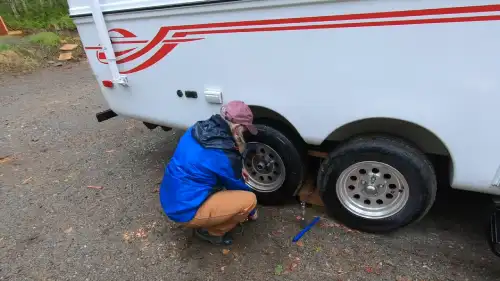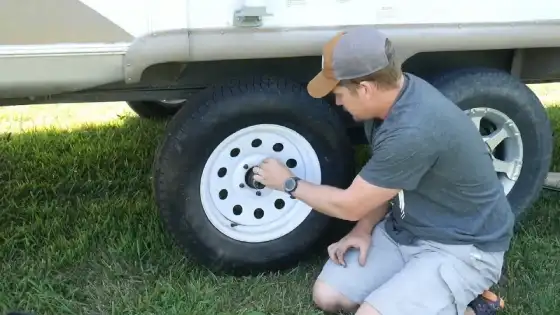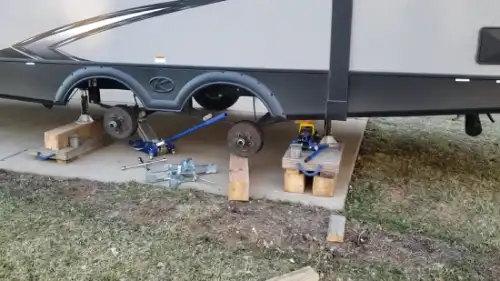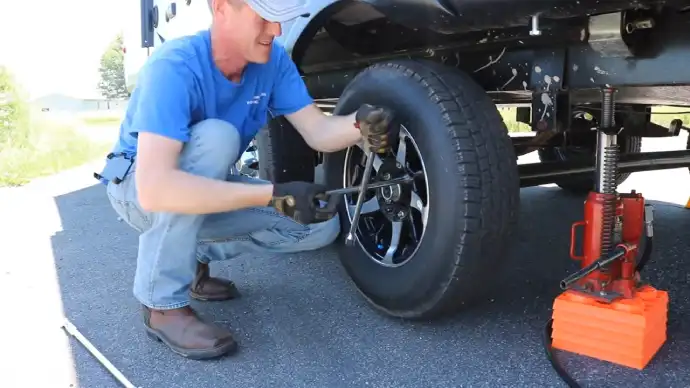Last Updated on July 10, 2023
Traveling with a trailer can lead to an unforgettable experience. However, when a flat tire occurs, it can quickly turn that experience into a frustrating and even dangerous one. To change a tire on a travel trailer, you need to jack it up safely and correctly.
Upgrading your travel trailer’s tires is more challenging than it seems. It’s vital to follow each process step carefully to prevent unfortunate accidents and ensure efficiency. It involves securing the travel trailer, positioning the jack, lifting it, and removing the tire.
This guide provides your ability to change a tire on your travel trailer with ease and security in case of a flat while on the road. Following the formal process outlined will make you feel confident and at peace.
Jacking up a Travel Trailer to Change a Tire: Steps to Follow

To facilitate replacing a tire on a travel trailer, it is necessary to employ a proper technique for jacking up the trailer. You can do this by following these steps:
- Step 1: Secure the travel trailer
- Step 2: Position the jack
- Step 3: Lift the trailer
- Step 4: Remove the tire
- Step 5: Install the spare tire
Step 1: Secure the Travel Trailer
Before attempting to elevate the vehicle, it is crucial to ensure that the travel trailer is parked on a flat and level surface. To prevent the trailer from rolling, and wheel chocks are in place on the opposite side. Failure to take these precautions could result in serious injury or damage to the trailer.
Initially, park the trailer on a flat and level surface. This will ensure the trailer is stable and will not tip over while being jacked up. Next, engage the parking brake to prevent any movement. As a result, the trailer from rolling or sliding while being elevated.
Then, place wheel chocks on the trailer’s opposite side so it does not roll. This will provide an extra layer of safety and ensure that the trailer remains in place while being jacked up.
Step 2: Position the Jack
Keeping the jack under the trailer’s frame near the flat tire is crucial for a safe and efficient tire change while preventing vehicle damage. Choosing a suitable jack point is important, typically found in the owner’s manual. Slide the jack under the trailer’s frame, ensuring it’s close to the tire that needs replacing.
The jack pad must be securely positioned on a sturdy part of the frame to ensure maximum safety. Below is a table that outlines some common jack points for different types of travel trailers. Before changing a tire on a travel trailer, you should always consult the owner’s manual.
| Type of Travel Trailer | Jack Point |
| Fifth Wheel | Cross member of the frame |
| Travel Trailer | Main frame rail near the wheel |
| Pop-up Camper | A-frame near the tongue |
Step 3: Lift the Trailer
You must lift the trailer slowly and steadily using the appropriate tool to change a flat tire. Once the jack is properly positioned, begin pumping the handle or using a suitable tool to lift the trailer. As the trailer begins to lift, keep a close eye on the jack stands to ensure they properly support the trailer’s weight.
Ensuring the trailer is stable before proceeding with the tire change is important. When the flat tire is off the ground, removing the lug nuts and replacing the tire is safe. After the tire change is complete, lower the trailer slowly and carefully, and make sure all lug nuts are tight.
Step 4: Remove the Tire
Removing the flat tire is a crucial step in ensuring safe travel and avoiding potential hazards on the road. After lifting the trailer, it is important to use a lug wrench or tire iron to loosen the lug nuts on the wheel.
Carefully remove the lug nuts and remove the flat tire from the wheel hub. This requires a bit of strength and caution as the tire may be heavy and difficult to maneuver. Setting the flat tire aside and placing it out of the way is important to avoid tripping hazards or damaging the tire further.
After removing the flat tire, inspecting the wheel hub and brake assembly for any damage or wear is important. Check for any signs of wear on the brake pads or drum, and ensure that the wheel hub is clean and debris-free.
This is also a good time to inspect the spare tire and ensure it is properly working before installing it onto the wheel hub. Take your time and follow proper safety procedures when removing and installing a tire on a travel trailer to avoid accidents.
Step 5: Install the Spare Tire
After checking out the hub and brake assembly for damage or wear, the next step is to carefully align and secure the spare tire onto the wheel hub. You can do this by aligning the spare tire with the wheel hub and ensuring the lug bolt holes align.
Once aligned, insert the lug bolts and hand-tighten the lug nuts. Tightening the lug nuts in a star or cross pattern is important to ensure even tightening. To complete the process, lower the trailer slowly and steadily until the spare tire rests on the ground.
What Mistakes Should You Avoid When Jacking Up Your Travel Trailer?

When jacking up your travel trailer to change a tire, it’s important to avoid common mistakes that could lead to serious accidents.
1. Using an Incorrect or Unsuitable Jack
Choosing the appropriate jack for lifting a travel trailer or RV is crucial to ensure stability and prevent potential accidents. Using an incorrect or unsuitable jack can lead to instability, which can cause the trailer to tip over or collapse. Using an unsuitable jack can also damage the trailer’s frame, axles, or tires.
To avoid using an incorrect jack, it is essential to check the trailer’s weight and the jack’s weight capacity. The jack should have a weight capacity that exceeds the trailer’s weight to ensure stability. Additionally, the jack should have a large base and stable construction to prevent it from sinking or tilting.
2.Not Following the Manufacturer’s Recommendations:
Following the manufacturer’s recommendations is crucial for ensuring proper jacking and support of the weight of a trailer. Failure to follow these guidelines could result in serious accidents, injury, or damage to the trailer. Here’s why it’s important to jack up a travel trailer according to manufacturer instructions:
The manufacturer’s guidelines consider the trailer’s specific design and weight distribution. Using an incorrect jacking point or technique could result in the trailer tipping over or becoming unstable.
- The manufacturer’s recommended jacking points are designed to distribute the trailer’s weight evenly and prevent damage to the frame or chassis.
- The manufacturer’s guidelines also specify the type of jack to use. Using an unsuitable jack could cause damage to the trailer or the jack itself, as mentioned earlier.
- After the trailer has been jacked up, the manufacturer may provide specific instructions on supporting it, such as jack stands or blocks.
- Ignoring the manufacturer’s guidelines could ensure the warranty and insurance coverage on the trailer is maintained.
3. Insufficient Stabilization
Previously, we discussed the importance of following the manufacturer’s recommendations when jacking a travel trailer. However, even if the instructions are followed correctly, the lack of proper stabilization can lead to accidents or damage to the vehicle.
Before lifting the trailer, chocking the wheels on the opposite side is crucial to prevent any rolling or movement. Additionally, stabilizing jacks should be placed underneath the trailer frame to provide sufficient support. These jacks should be positioned on a solid surface and adjusted until they contact the frame.
4. Overloading Jack’s Capacity
Overloading a jack’s weight capacity can result in its failure and cause accidents or injuries. For instance, AAA found that many tire-changing accidents were caused by jacks with weight capacities lower than the vehicle, resulting in the jack collapsing and the vehicle falling.
Therefore, it is crucial to check the specifications of the jack and ensure it can safely handle the weight of the travel trailer before attempting to jack it up.
Moreover, overloading the jack’s capacity can also cause damage to the trailer’s frame or suspension system. If you want to avoid tipping or sinking your jack, ensure the trailer’s weight is balanced. Follow the manufacturer’s instructions and use the right jack to ensure a safe and successful tire change.
- Check the specifications of the jack before use
- Ensure the weight of the trailer is evenly distributed
- Use a stable surface to avoid tipping or sinking
- Make sure you follow the manufacturer’s instructions
5. Not Using Jack Stands
Failure to utilize jack stands when lifting a trailer can lead to disastrous consequences and pose a serious threat to personal safety. Jack stands necessary for additional support and stability to the trailer, as the jack alone cannot hold the trailer’s weight for an extended period.
The trailer can collapse or tip over without jack stands, causing severe damage or injury to nearby individuals. Moreover, it is crucial to use jack stands that are rated for the weight of the trailer to prevent them from buckling or collapsing.
The jack stands should be placed on a hard, level surface and under the trailer’s frame or axle. It is also essential to ensure that the trailer is not overloaded beyond its capacity, which can cause the jack stands to fail.
Do travel trailers have self-leveling jacks?

Auto-leveling systems, commonly found on larger RVs, can sometimes be installed on travel trailers to provide self-leveling jacks for easier tire changes. However, it is important to note that not all travel trailers have auto-leveling systems. They are commonly found on fifth wheels, toy haulers, and motorhomes.
There are a few key things to keep in mind for those travel trailers with auto-leveling systems. To begin with, ensuring the system is properly calibrated and functioning correctly before using it is important.
Also, it is important to follow the manufacturer’s instructions carefully when using the system to ensure it is used safely and effectively. Moreover, while auto-leveling systems can make tire changes easier, they must replace proper maintenance and care.
What size jack do I need to lift a travel trailer?
Determining the appropriate weight capacity for lifting a travel trailer requires calculating the tongue weight based on the fully loaded weight of the trailer. As mentioned in the background information, the rule of thumb for a boat trailer is 7-10% of the weight of your fully loaded trailer.
Therefore, if you have a 6000lb loaded trailer, using 10% as an example, you would require a tongue jack with a capacity of 600 lbs. Here’s an estimate based on the trailer’s weight to further assist with determining the appropriate size jack needed to lift a travel trailer.
| Travel Trailer Weight | Tongue Jack Capacity |
| Up to 2,000lbs | 500lbs |
| 2,001-3,500lbs | 750lbs |
| 3,501-5,000lbs | 1,000lbs |
| Over 5,000lbs | 2,000lbs |
Where is the best place to jack up a trailer?
To ensure proper lifting of a trailer, the jack should be positioned near the end of the axle, ensuring enough room for the support stands between the jack and the tire sidewall. This is important to ensure that the trailer’s weight distributes evenly and the jack can lift the trailer without causing damage.
When jacking up your trailer, consider the following:
- Look for a flat and level surface to park the trailer on before lifting it.
- Check the owner’s manual to determine the recommended jack points for your specific trailer model.
- Avoid jacking up the trailer on the frame or the axle itself, as this can cause damage.
- Use support stands to keep the trailer steady while changing the tire.
Can you level a travel trailer with scissor jacks?

Moving on to the next topic, it is important to note that scissor jacks do not serve to level a travel trailer. As mentioned earlier, these jacks are only meant to prevent bouncing and unnecessary movement inside the RV.
Attempting to level your camper with scissor jacks can lead to serious damage to both your RV and the jacks themselves. Scissor jacks aren’t built to support the weight of the entire trailer, so they can be dangerous and unstable.
Using leveling blocks or stabilizing jacks specifically designed for leveling purposes is always advisable. Your camper will be level and stable with these products, so it’s more enjoyable to camp with them.
Changing a Travel Trailer Tire: Prioritize Safety and Efficiency
Changing a tire on a travel trailer is a formal process that requires attention to detail and adherence to proper safety procedures. It is crucial to use the correct equipment and follow the necessary steps to ensure the process is done safely and efficiently.
There’s a possibility of causing damage or the jack not being strong enough to support the trailer’s weight, but following the proper procedures can alleviate those worries. In fact, prioritizing safety and changing the tire on a travel trailer can prevent potential damage and save time in the long run.
While it may be tempting to rush through the process, it is essential to remember that safety should always come first. Consulting a professional can provide additional guidance and peace of mind if needed. Ultimately, it’s important to take a formal approach when changing a travel trailer tire.



